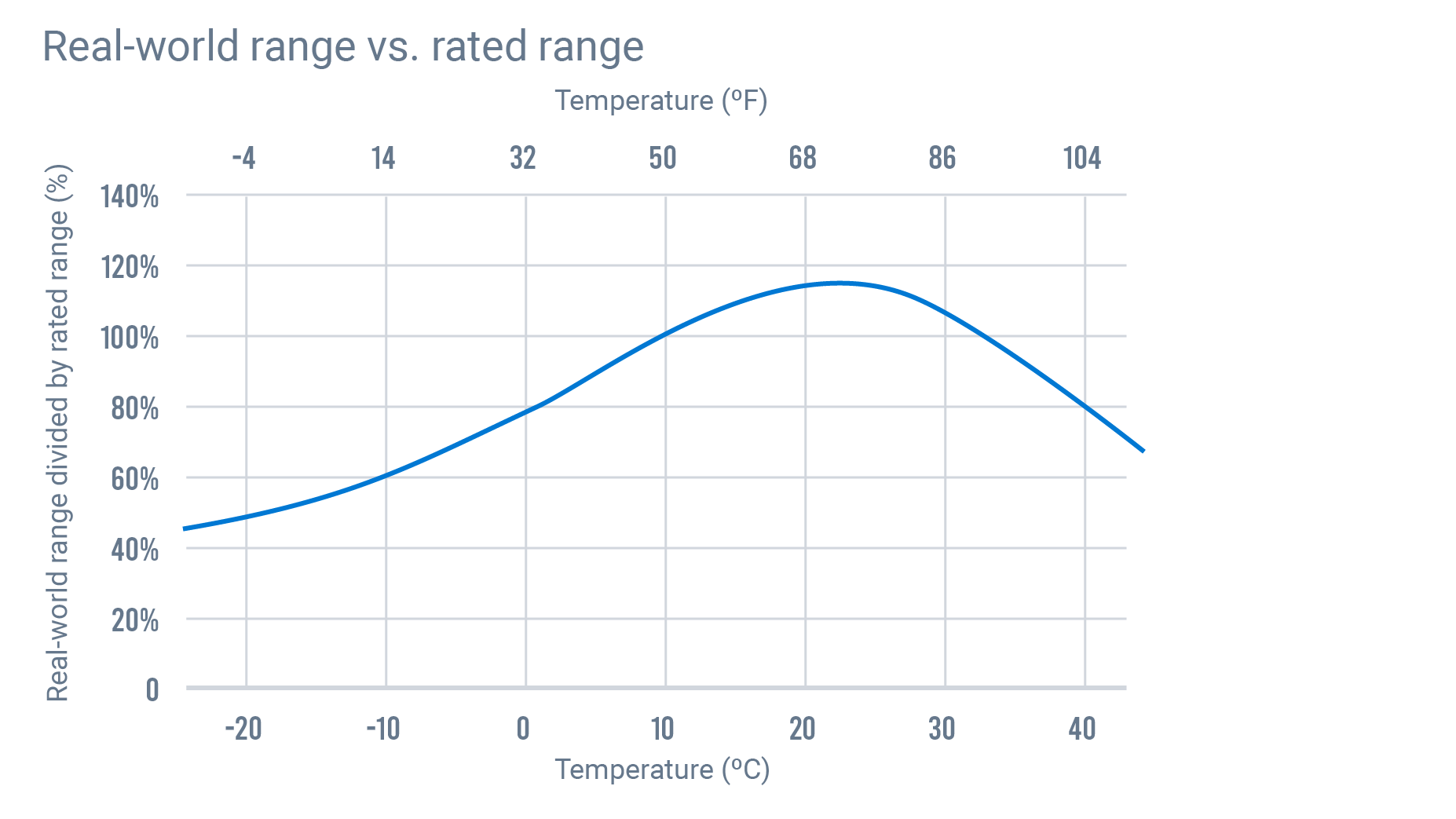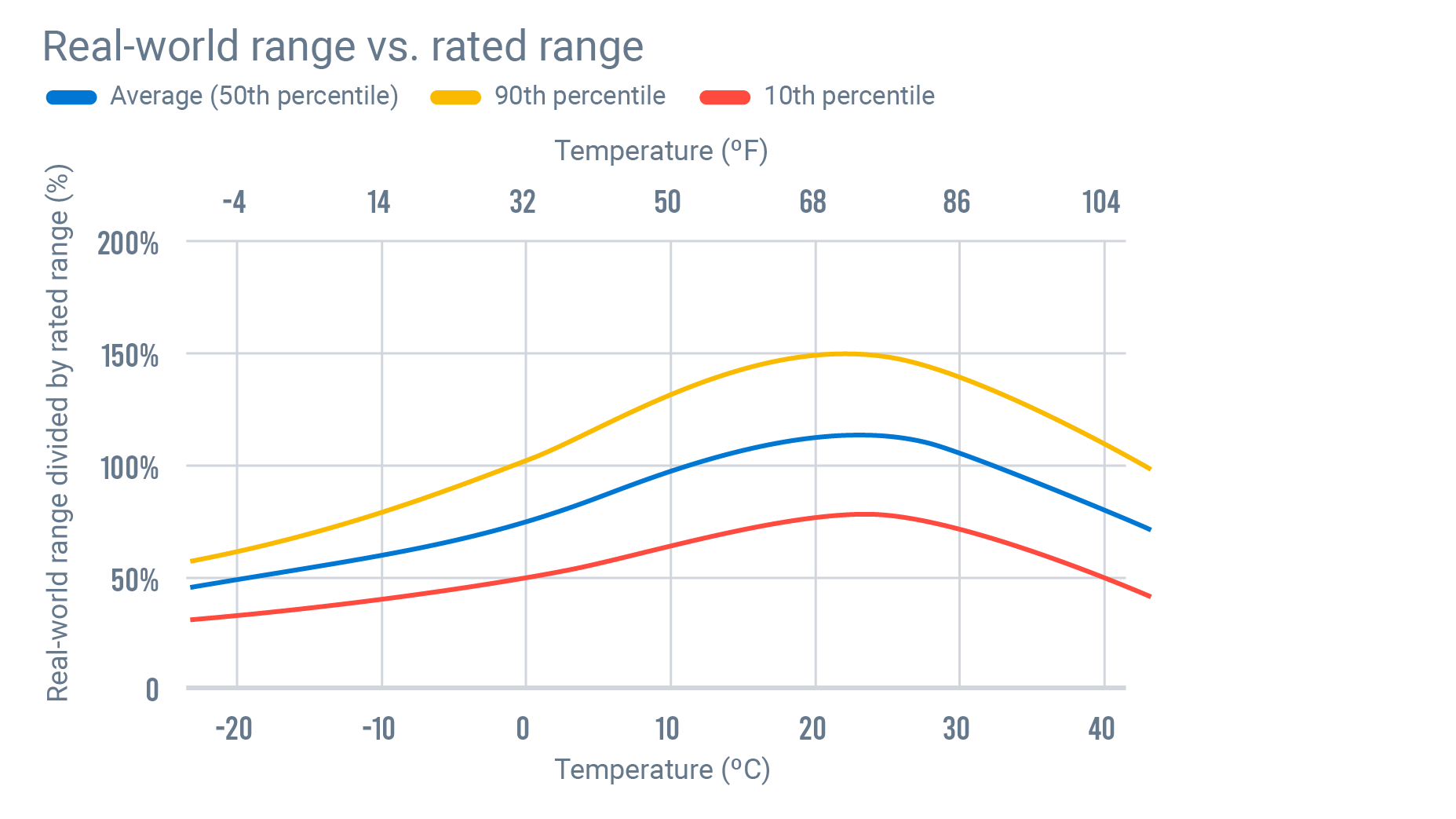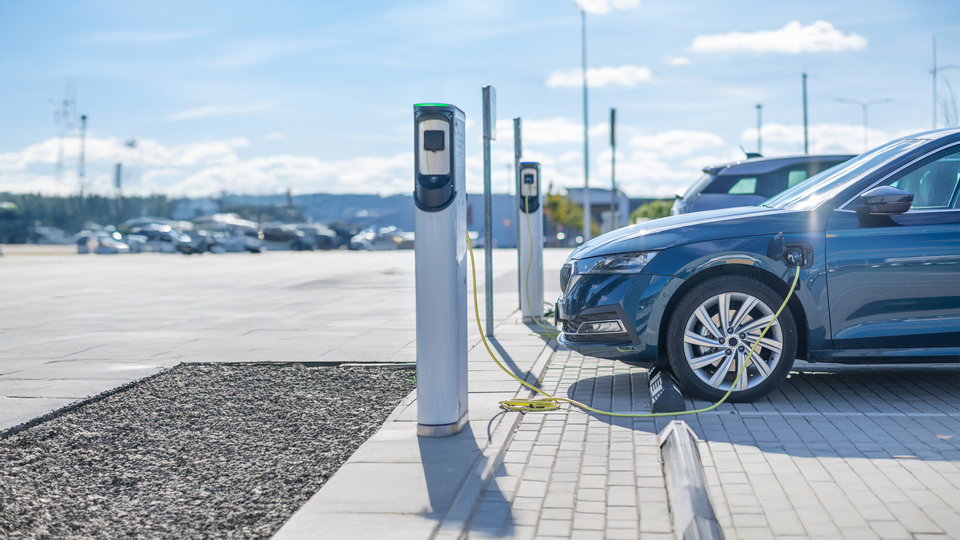To what degree does temperature impact EV range?
Understand how temperature affects how far your EV can go on a full battery.

Senior Manager, Sustainable Mobility at Geotab
Feb 6, 2023
Updated: Nov 30, 2023

As companies explore the benefits of introducing EVs into their fleets, they’ll need to consider what EV range will be required, and how to account for their unique operating conditions, including seasonal variability. Following an in-depth analysis of EV data – drawn from 4,200 connected battery electric vehicles (BEVs) and 5.2 million trips – we explore the impact temperature has on EV range.
Here we reveal the optimal operating temperature, how much range you might expect to lose in the dead of winter or the peak of summer, and key takeaways on what you can do to extend the daily range of your EVs.
Understanding EV range
Range is the distance an EV can drive on a single charge. A vehicle’s published range is based on standardized testing performed on a dynamometer in a test facility. However, as EV drivers know, the officially listed range is best taken as a guideline.
EVs, like gas cars, perform differently in real-life conditions depending on terrain, passenger load, speed, driver behavior and outdoor temperature. These factors all impact the vehicle’s fuel economy (how far a vehicle can go on a given amount of fuel - kWh in the case of EVs - and therefore its range.
The more energy a vehicle’s battery pack can store, the longer its range, but the fuel efficiency of the vehicle is impacted by the vehicle’s design (weight, shape, size, etc.). For a bus to go as far as a 60kWh sedan, it would need a much bigger battery. However, external conditions can negatively or positively impact the vehicle’s fuel economy on any given trip. This is not unique to electric cars. Slamming on the accelerator between traffic lights or driving on a frigid day means worse efficiency regardless of how you fuel your car.
See also: Overcoming EV range anxiety with electric vehicles
Electric vehicles in cold weather
Since EVs first came to market, a frequent knock against them was that they didn’t work well in winter. While many Canadian and Norwegian EV drivers beg to differ, it is true that temperature is a culprit when it comes to range.
Day-to-day range is affected by temperature primarily due to auxiliary heating and cooling. Not only does energy from the battery power the vehicle, it also powers auxiliary systems, most notably regulating the temperature of the vehicle cabin and battery.
People often assume range loss in cold temperatures is due to reduced battery performance. While lithium-ion batteries are more sluggish in extreme temperatures (cold temperatures impact their ability to store and release energy), this has far less impact on range than auxiliary load. Additionally, automakers have designed battery thermal management systems to keep batteries within an optimal temperature range, further minimizing loss in battery performance (but costing us auxiliary load).
How does temperature impact EV range?
We set out to fully understand the impact temperature has on range, and whether all EV models were impacted equally. To find out, Geotab looked at anonymized data from 5.2 million trips taken by 4,200 EVs representing 102 different make/model/year combinations, and analyzed average vehicle trip efficiency by temperature.
Our analysis showed that:
- Most EVs follow a similar temperature range curve, regardless of make or model.
- While both cold and hot temperatures impact range, colder climates have a larger impact.
- 70F (21.5C) is the vehicle trip efficiency sweet-spot.

Chart 1: Temperature range curve
Our data shows that most EVs follow the same efficiency curve by temperature, irrespective of their make, model or year. The above graph shows the range an EV will get (on average) compared to its rated range at any given temperature. At optimal temperatures, EVs are performing better than their rated range, peaking at 115% at 70F or 21.5C. So, most EV owners are exceeding the rated range of the vehicle in prime temperature conditions.
As you turn up or down the temperature, however, the loss of range is apparent. At 5F (-15C), EVs drop to 54% of their rated range, meaning a car that is rated for 250 miles (402 km) will only get on average 135 miles (217 km).
Cold gets a bad rap, but it turns out heat is also culpable.
Interestingly, if you look closely you’ll notice the range drops slightly faster (the slope is steeper) as you increase temperature. The real-world impact manifests less in hot temperatures however, as Earth’s climate doesn’t often hit temperatures beyond 122F (50C), so we don’t know (nor hopefully need to care) what happens to our range after that point.
The cost of being comfortable
It’s no coincidence that across the board the most efficient trips were taken on days where the average outdoor temperature was 70-71 F (21-22C). Interesting fact: this happens to be the temperature at which we humans like to keep our homes.
If you get into your car and the temperature outside is below 68F, you are more likely to turn on the heat; above 71F and you’ll probably switch on the AC. Getting the cabin temperature to a comfy house-like condition draws energy from the battery that could have otherwise been used to move the car.
Like humans, batteries also like to be comfortable and function best at moderate temperatures (although they’re a bit more cold-friendly and tolerate a wider temperature range). An EV’s on-board thermal management system is designed to draw energy to warm or cool the vehicle’s battery as needed. This ensures it operates in that ideal range and also helps prevent battery degradation. Therefore, the car is working to heat/cool both the occupants and the batteries in cold or hot conditions.
The best and the worst performers

Chart 2: Range curve with 10th and 90th percentiles shows the distribution of trip efficiency one might expect at any given temperature.
The above range curve is based on the average efficiency of all trips in our databases taken at a given temperature. Because these trips were made in the real world, they were exposed to a wide variety of external factors that can impact vehicle efficiency such as terrain, speed, driver habits, trip length and start-conditions (e.g., if the trip started in a climate-controlled garage).
This analysis does not attempt to isolate the relative impact of each factor on range. It is reasonable to assume that the most efficient trips (or best performers) at any given temperature will be due to a combination of external factors that influence vehicle efficiency. In a separate analysis, we look at the relative impact of temperature and speed.
Overall, the best performers (those in the 90th percentile) obtained 32% more range than the average, and had twice the range as those in the worst 10th percentile. This suggests there is some leeway with how far you can expect to drive on a single charge, which may be partially within your control.
While for the most part all vehicle models followed this temperature range curve, EVs utilize different battery management systems. For example, several newer EVs are equipped with a heat pump, a very efficient climate control method. The expectation is that their temperature range curves will be more flat than those without.
Tips to extend your EV range on hot and cold days
As outlined, the major offender for causing range loss in cold and hot temperatures is auxiliary load. Therefore, minimizing auxiliary load will help extend those miles:
Take advantage of the amenities that come with your car (heat or cool the human, not the air)
Be sure to use those heated seats and steering wheel. Heating the cabin air can draw 3000-5000 watts, and is much less efficient than heating your seat and steering wheel (around 75 watts) which transfers heat to your body via conduction. Using these increasingly common features can keep you comfortable without resorting to the cabin heater. However, in very cold temperatures, minimizing cabin heating can only take you so far, and you will still lose energy from your battery thermal management system.
Pre-condition your vehicle
Just like you would before exercise, warm up before a long trip! If it’s hot, cool down. Turning on your car’s heaters while it’s still plugged in will minimize the auxiliary load by warming (or cooling) your car before it starts its trip. Take advantage of the guilt-free pre-conditioning that EVs allow. If the option is available to you, park in a temperature-controlled garage to get a similar effect.
Keep your vehicle plugged in on extreme cold or hot days
In addition to the benefits of preconditioning before your trip, automakers recommend vehicles are plugged in during very hot or very cold days when the vehicle is not in use. (Note: this is not the same as actively charging, which is better to avoid in extreme conditions, particularly heat). Having a vehicle plugged in allows the internal system to maintain battery temperature controls, prolonging the life of your battery in the long run.
Drive conservatively
No matter the weather, one factor that always affects your mileage range is how you drive your EV. Excessive acceleration and braking, and driving at high speeds all cost energy. And that’s not just better for your mileage range, it’ll also keep you and your passengers safer, especially on wintery roads. By anticipating the need to brake and avoiding harsh braking, you will allow your EVs regenerative braking system to work, recovering energy and storing it back into the battery. The only thing to bear in mind is that in extreme cold, the regenerative braking system will be less effective because cold batteries can't accept as much energy as warm batteries can.
Use the eco mode
Every EV has a slightly different function to their eco mode, but generally they all work to reduce power consumption and increase mileage by reducing the energy supply to the drive motor and high energy consumption features such as cabin heaters. In winter, eco modes can actually make your car safer to drive. By reducing the power to the motor, the car accelerates slower, which reduces the possibility of wheel spin on ice- or snow-covered roads.
Check your tire pressure
Tire pressure drops as the ambient temperature falls, leading to greater rolling resistance and reduced mileage range. It’s really good practice to check your tire pressure every month, but particularly as the outside temperatures change considerably with the seasons.
Know where your fast chargers are
Cold batteries have a greater resistance to charging, meaning that EVs charge slower in low temperatures. Make sure you have a 240V level 2 charger available for your main charge – whether that’s overnight, or while you’re at work. And if you’re planning a long winter road trip in your EV then it’ll pay to map out where the fast charging stations are.
As battery sizes have increased with new EV models, range loss has become less of an issue. Larger capacity means little impact on most daily trip needs, and charging infrastructure continues to expand for that occasional road trip.
Additional info for fleets
Understanding how to choose the right electric vehicle for your specific fleet needs begins with gathering and evaluating telematics data. Fleets can pinpoint those vehicles in their fleet that are ready to go electric based on operational and financial requirements by conducting an EV Suitability Assessment. The analysis assumes the worst-case temperature, so fleet managers can be confident that their EVs will be range-capable in winter chills, summer heat waves, and everything in between.
Once fleets adopt EVs, knowing each vehicle’s real-world range is critical to ensure the right vehicle continues to be matched with the right job and make informed replacement decisions as the battery degrades. Using Geotab’s BEV range capability report, fleets can receive these insights based on factors like terrain, temperature and vehicle-specific usage patterns.
Fleet electrification is still a new topic for many fleets. If you’re unsure where to begin your research, visit Geotab’s Fleet Electrification Knowledge Center for educational insights, resources and fleet success stories.
This blog was originally published on May 25, 2020.
Subscribe to get industry tips and insights

Senior Manager, Sustainable Mobility at Geotab
Charlotte Argue is a sustainable transportation and electric vehicles (EVs) thought leader, working on green fleet initiatives since 2008.
Table of Contents
Subscribe to get industry tips and insights
Related posts

9 strategies to increase fleet fuel efficiency and lower fuel costs
July 8, 2025
4 minute read

Beat the Heat: Easy Ways to Maximize Your EV Range This Summer
June 19, 2025
2 minute read

Charlotte Argue: Breaking down cost barriers for electric fleets
June 5, 2025
4 minute read
.jpg)

